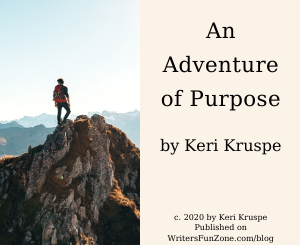Don’t Go Overboard: Managing Proportion for Novel Writing by Kay Keppler
 Welcome to the next installment of craft posts by monthly guest columnist, Kay Keppler, on novel writing. Today she’ll share about how the right proportion in a scene is key to not boring your audience.
Welcome to the next installment of craft posts by monthly guest columnist, Kay Keppler, on novel writing. Today she’ll share about how the right proportion in a scene is key to not boring your audience.
You can contact Kay through the Writer’s Fun Zone or at kaykeppler AT yahoo DOT com to ask questions, suggest topics, or tell her she’s off her rocker. (She let me say that!)
***
What’s wrong with this passage?
“Bullshit!” McKittrick yelled above the engine noise. The boat chugged and lurched through the choppy water, now a dull, angry green. He thought he might puke. He thought he might die. “You’re a liar. You lied before, you’re lying now.” He gripped the gunwale for support.
“Listen to me,” Bosch yelled. He saw his life pass before his eyes, and what he saw, he didn’t much like. But if this guy could help, he’d use him. He’d use anybody. “You said you remember every case.”
“I do, goddamnit! I can’t forget them.” How could he forget? They were the sad ones, the lost ones, the dangerous and defiled ones.
“Cut it back!” Bosch knew that if they couldn’t get the boat under control, they’d both die.
McKittrick pulled the throttle back and the boat evened off and the noise reduced.
Sorry, Michael
With apologies to Michael Connelly, this passage is highly adapted from The Last Coyote. Connelly’s protagonist, Bosch, wants McKittrick, an ex-cop, to help solve a case. This is the way Connelly wrote the passage:
“Bullshit!” McKittrick yelled above the engine noise. “You’re a liar. You lied before, you’re lying now.”
“Listen to me,” Bosch yelled. “You said you remember every case.”
“I do, goddamnit! I can’t forget them.”
“Cut it back!”
McKittrick pulled the throttle back and the boat evened off and the noise reduced.
Overwriting, especially in dramatic scenes like this one, can kill the momentum of your story. Excess description, or showing detail that is already obvious from the dialogue, slows the action. Overtelling the scene can bore or even patronize your readers.
The Right Proportion
Problems like these are problems of proportion. You want to give readers enough detail and discussion to hold their interest, but you don’t want to give more detail than the scene requires. In an action scene, such as this one from The Last Coyote, readers want to know what happens next. They won’t be as interested in how the water looks or what the characters’ personal demons are.
Proportion also can go haywire when writers use their hobbies or expertise to flavor a narrative. While specialized knowledge can do a lot to lend authenticity to a tale and introduce readers to a new world, including too much detail can stall your story. Worse, it can drag out your page count, postpone your conflict, and bore your readers.
Too Big? Too Small? Or Just Right?
How can you be sure you’re providing the right amount of detail? Read your work carefully. Be sure that if you’re giving something a lot of space in your novel, it will pay off. You don’t want to go into a fifteen-page description of a 1930s-era World Series game and then not have baseball or teamwork be a major component of your story. Your readers will feel cheated.
Proportion is important, but you also don’t want to cut everything that doesn’t ruthlessly advance your plot. There will always be room for description or a philosophical rumination that reveals character or establishes atmosphere. Just be sure that when you include these side trips that they reflect and harmonize with your central plot and its themes, rather than hang out there like wet diapers on a sagging clothesline.
Checking for Size
If you’re in doubt that you’ve added too much detail, give your book a rest for a few days and come back to it with fresh eyes. What parts do you like the most? If what you like best are sections that don’t advance the plot, maybe you need to rethink your plot. Ask your critique partner or a trusted friend or colleague for their opinion, too.
Once you see how proportion can throw off your story, you can use it to advance your story. For example, if you have a surprise that you want to spring on your readers, shorten the buildup until you get there. Or spend more time on another scene to mask an important development.
Proportion is a Tool
Learn to control the proportions of your story. If you can’t, you may damage your work. But used well, proper proportions can draw readers into your book and bring it to life.
***
 Kay Keppler (www.kaykeppler.com) is an author (Zero Gravity Outcasts, Betting on Hope) and editor of fiction and nonfiction (Angel’s Kiss, Outsource It!) who lives in northern California. Contact her here or at kaykeppler@yahoo.com to ask questions, suggest topics, or if you prefer, complain.
Kay Keppler (www.kaykeppler.com) is an author (Zero Gravity Outcasts, Betting on Hope) and editor of fiction and nonfiction (Angel’s Kiss, Outsource It!) who lives in northern California. Contact her here or at kaykeppler@yahoo.com to ask questions, suggest topics, or if you prefer, complain.







Good tips – so agree with proportion and cutting out unnecessary noise. I’m a speed reader and will often skip a lot of guff and if the passage drones on, my interest is lost and the book closed. Nice post.
Wow, great article and I loved the example you gave!
I am a video marketer and blog about video strategy, execution and transformation. I have several articles to help authors market their books, so I think sharing this link with my author followers would be helpful for them!
Good writing instructions. I, too, an a speed reader and always skip over all of the fluff (it can be aggravating).
Rachel recently wrote The 16 Habits of Highly Unsuccessful People
Thanks, Rachel, and congratulations on “The 16 Habits of Highly Unsuccessful People.” I’m sure you’ve cut out all the fluff!
Hi Becky–I’m sure Beth and I would both be thrilled if you shared this link with your readers. Thanks!
Thanks! I agree, there’s nothing worse than reading six paragraphs about what the character thinks about saying…before he says anything at all. Happy reading!